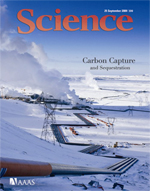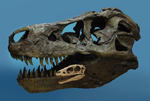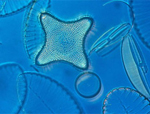 Carbon Capture and Storage
Carbon Capture and Storage
Introduction to Special Issue
Carbon dioxide emissions from fossil fuel combustion are a
major contributor to climate change. One step toward
reducing these emissions is to capture the carbon dioxide
generated during combustion and store it in a suitable
place. A special section of the 25 Sep 2009 Science
explored some of the main approaches this process of carbon
capture and sequestration (or storage) (CCS) and how they
might be accomplished. A Review article discussed the
technical challenges associated with the capture, transport,
and storage of carbon dioxide and the political hurdles that
need to be overcome for a viable CCS industry to be created.
Four Perspectives highlighted specific approaches to carbon
capture and sequestration, from amine scrubbing in power
plants to storage in onshore geological formations and
offshore sediments. And the News section offered a
User's Guide to the Carbon Cycle, a map of major CCS
projects around the world, and profiles of two new projects
in China that mark the country's first major steps toward
trapping carbon emissions.
Communication and
Cognition
Ten-month-old infants will continue to look for a hidden toy
at its initial hiding location even after observing that it
has been moved to another location. Some theorists believe
that this curious behavior indicates that infants have a
profoundly different conception of the world than adults,
but a new study by
Topál
et al. in the 4 Sep 2009 Science showing
that adult domestic dogs make the same mistake, supports the
alternative view that both infants and dogs persevere in
erroneous searching because of communicative cues (such as
eye contact) from the experimenter, leading both to follow
human instruction over their own visual experience (see the
related
ScienceNOW story by V. Morrell). There is an
interesting difference between dogs and infants, however.
Dogs did not make the search error if the person hiding the
object in the second location was not the same person who
hid it in the first location, whereas children made the
error whether the person was the same or not. The authors
interpret this as evidence that children take instruction
from all adults equally, considering it as general cultural
information, whereas dogs are sensitive only to
communication from humans in the context of following
immediate orders. The team also observed that human-reared
wolves do not make the same search errors as dogs or
infants, suggesting that dogs have evolved a more
sophisticated understanding of human communication. A
podcast interview with lead author Josef Topál and a
Perspective by M. Tomasello and J. Kaminski; discussed
the findings.
 Anti-HIV Antibodies
Anti-HIV Antibodies
Despite over two decades of research, a vaccine against
HIV-1 remains elusive. A top priority for researchers is the
development of a vaccine that can teach the body to make
potent antibodies against the many strains of the virus.
These so-called "broadly neutralizing antibodies" have been
shown to provide the best protection against infection in
non-human primate models of the disease. Unfortunately, the
handful of these antibodies found so far display limited
breadth and potency and have proven difficult to exploit by
means of vaccine design. Now, in a study published online in
Science Express on 3 Sep 2009, an international
research team reports that it has discovered the most
powerful, broad-acting antibodies yet against multiple
strains of HIV ( see the
News story by J. Cohen).
Walker et al. first collected blood from some
1800 HIV-infected patients in Africa, Asia, Europe, and
North America, and then used a high-throughput culture
system to screen for antibodies that could derail more than
a dozen different strains of the virus. From one sub-Saharan
African donor, the researchers identified two new potent and
broadly neutralizing antibodies, dubbed PG9 and PG16, that
could prevent infection in more than 70% of the 162 viral
strains tested in cell culture. The antibodies bind trimers
of the HIV envelope protein, and a motif that includes
conserved regions of the gp120 subunit. The findings provide
a framework for the design of new vaccine candidates that
can elicit a broadly neutralizing antibody response.
Brain Energetics
The brain accounts for just 2% of our body mass, yet
consumes 20% of the body's energy. Action potentials that
carry electrical signals along the axon (and dendrites) and
postsynaptic potentials generated by neurotransmitters that
are released at the synapse and act on the target neuron
both consume energy, but their respective contributions are
the subject of ongoing debate. In a Report in the 11 Sep
2009 Science
Alle
et al. weighed in on the subject -- with some
unexpected results. By combining direct recordings of
currents running through rat hippocampal neurons with
modeling and simulation approaches, the researchers found
that neuronal impulses in the mammalian brain travel about
three times more efficiently than previously thought,
accounting for a surprisingly small fraction of the entire
energy expenditure for neural information processing. As
noted in a related
ScienceNOW story by C. Willyard, the findings
suggest that more energy is expended to ferry signals from
one neuron to the next than to move electrical signals along
the axon. An accompanying
Perspective by P.J. Magistretti discussed the relevance
of the results for interpreting brain imaging signals, which
are tightly coupled to energy use.
 Tiny
Tyrannosaur
Tiny
Tyrannosaur
Tyrannosaurus rex is the best known of several
tyrannosaurid species, which were the dominant large
dinosaur predators during the Late Cretaceous. These
multi-ton beings had several distinct, specialized features,
including an oversized skull, huge hindlimbs, and tiny arms,
that have been thought to have evolved in concert with their
large size and carnivorous diet. Now, in a Report published
online in
Science Express on 17 Sep 2009,
Sereno
et al. describe a much smaller tyrannosaurid,
no more than 3 meters in length, that displays these same
specialized features -- and predates its larger relatives by
tens of millions of years. The new species, Raptorex
kriegsteini, was discovered in the Lujiatun Beds in
northeast China and is estimated to be a young adult, 5 or 6
years old. As with tyrannosaurids, its skull is
proportionately large -- measuring approximately 40% of its
trunk length -- and was equipped with expanded jaw-closing
musculature. Thorough analysis of this fossil indicates that
contrary to previous thinking, characteristic tyrannosaur
features evolved as an efficient predatory strategy at
relatively small body size and later scaled up with little
modification in descendants with body masses approaching 100
times greater.
Closer Comet Source
Long-period comets, with their eccentric orbits and periods
ranging from 200 years to thousands or even millions of
years, are thought to come from the outermost region of the
solar system -- the Oort Cloud, which extends from 20,000 to
100,000 astronomical units (AU; 1 AU is roughly the mean
distance from the Earth to the Sun). The icy bodies in the
Oort Cloud are thought to be the surviving population of
unincorporated remnants of planetary building blocks that
were gravitationally scattered outward by the growing
planets. In the 4 Sep 2009 Science (published online
30 Jul),
Kaib and Quinn reported that the source of long-period
comets may be closer to the Sun than previously thought.
According to their simulations, Oort Cloud objects can spend
most of their lives in the inner cloud -- at distances of
around 3000 to 10,000 AU -- and later be nudged into the
outer cloud, where they can be perturbed by planetary forces
and enter visible orbits in great numbers. This dynamical
pathway appears to be an important, if not the dominant
source of known long-period comets. An accompanying
Perspective by M. Duncan; noted that "Kaib and Quinn's
prediction of the mass of the inner Oort cloud is broadly
consistent with current planet-formation models" and that
their results "will encourage more complete beginning-to-end
simulations of Oort Cloud formation and dynamical
evolution."
 Marine Microbe Distribution
Marine Microbe Distribution
Quantifying the relative influence of present-day
environmental conditions and geological history on the
spatial distribution of species represents a major challenge
in microbial ecology. In the 18 Sep 2009 Science, two
Reports investigated how distribution patterns of marine
microbes are shaped by dispersal on a global scale.
Cermeño and Falkowski
analyzed fossil diatom assemblages from the world's oceans
over the past ~1.5 million years and showed that marine
diatom dispersal has not been constrained by geographic
barriers. Despite tremendous environmental variability
linked to glacial-interglacial climates, diatom communities
have evolved slowly through gradual changes over the last
1.5 million years, indicating that these communities have
considerable capacity to recover from climatic variation.
Moreover, the lack of dispersal limitation amongst marine
diatoms suggests that biodiversity at the microbial level
fundamentally differs from that of macroscopic animals and
plants for which geographic isolation is a common component
of speciation.
Hubert et al. showed how powerful marine
microbe dispersal can be. The researchers quantified the
influx of spore-forming thermophilic bacteria, which are not
metabolically active at cold in situ temperatures, into the
cold Artic seabed and estimated that these bacteria are
replenished at a rate exceeding 100 million spores per
square meter per year. The findings raise questions about
the origin of the thermophiles, their mode of dispersal, and
the implications for wider patterns of microbial
biogeography. A
Perspective by D.J. Patterson highlighted the studies.
Wind Power Potential
China is the world's largest carbon dioxide producer and the
world's second-largest producer of electrical power, 80% of
which it generates by burning coal. Still, demand for
electricity in China continues to increase at an annual rate
of ~10%. An affordable, carbon-free source of electrical
power generation would thus constitute an important way for
China to reduce its carbon dioxide emissions and other
environmental impacts of fossil fuels. In a Report 11 Sep
2009 Science,
McElroy et al. estimated the potential for
wind-generated electricity in China subject to the existing
financial conditions and government-approved bidding process
for new wind farms. The team used a compilation of global
meteorological data analyzed with a state-of-the-art
weather/climate model. Their analysis shows that although it
would require a substantial financial investment up front,
there is enough wind to generate electricity to supply the
nation's entire projected demand for 2030 (about twice what
is used now) at reasonable prices per kilowatt-hour.
Making Mother of Pearl
Nacre, commonly known as "mother of pearl," is a strong,
smooth, iridescent layer that lines the inside of mollusk
shells. It is composed of layers of uniformly oriented
crystals of aragonite (a metastable form of calcium
carbonate) separated by layers of organic matrix. In a
Report in the 11 Sep 2009 Science
(published online 13 Aug),
Suzuki et al. identified two proteins, Pif 97
and Pif 80, that regulate nacre formation in the Japanese
pearl oyster Pinctada fucata. After identifying the
Pif proteins in a calcium carbonate-binding assay (Pif 80
and Pif 97 turn out to be cleaved from a common precursor
protein), the team performed an in vivo "knockdown"
experiment using RNA interference (RNAi) to confirm the
proteins' function. They injected double-stranded Pif
messenger RNA (mRNA) into oyster tissue. This treatment
activated the cellular RNAi machinery, which catalytically
degrades endogenous mRNA molecules whose sequence matches
the introduced double-stranded RNA, resulting in a 50%
decrease in Pif mRNA level. Moreover, the injected specimens
showed dramatically reduced biomineralization and completely
lost the ability to form lamellar sheets of nacre, strongly
suggesting that Pif80 and Pif97 are directly involved in
creating the layered arrangement of aragonite crystals in
nacre. An accompanying
Perspective by N. Kröger noted that "[t]he work provides
the most complete data set to date for the role of any known
protein involved in mollusk biomineralization."
 Butterfly Navigation
Butterfly Navigation
North American Monarch butterflies undergo one of the most
magnificent long-distance migrations observed in animals,
traveling distances up to 4000 km to reach their
overwintering grounds in central Mexico each fall. As with
other insects, the monarch uses a time-compensated sun
compass to guide its journey. This navigation mechanism uses
the circadian clock to compensate for the positional change
of the sun in the sky throughout the day. Now, in a Report
in the 25 Sep 2009
Science,
Merlin et al. provide compelling evidence that
the primary timing mechanism for sun compass orientation
resides in the butterflies' antennae, rather than the brain,
as previously thought. The researchers observed that when
the butterfly's antennae are surgically removed, the insect
loses its normal southwestern orientation, even though the
brain's canonical circadian clock keeps normal time (as
indicated by the expression of clock genes during 24-hour
cycles). And when light input to the antennae was blocked by
blackening them with enamel paint, the antennal clocks
started to drift out of their normal phase relationship with
the prevailing lighting cycle. These findings pose a novel
function for the antennae that may extend widely to other
insects that use this orientation mechanism. An accompanying
Perspective by C.P. Kyriacou highlighted the study,
likening the butterfly antennal clock to "a standalone
global positioning system that one might use while driving."
Quantum Phase Formation
Quantum critical points are continuous phase transitions
occurring near absolute zero, often seen as fluctuations in
electronic ordering driven by an external magnetic field.
Because a quantum critical point can affect the properties
of a material well above absolute zero, the search for
unusual electronic phases of matter, such as unconventional
superconductivity, can be aided by their presence. However,
it has proven difficult to see the changes in thermodynamic
properties that must occur near quantum critical points
partly because the better known systems are tuned using
hydrostatic pressure, and thermodynamic measurements are
difficult to perform under such conditions. In a Research
Article in the 11 Sep 2009 Science (published online
6 Aug),
Rost
et al. combined specific heat and
magnetocaloric measurements to map an "entropy landscape" of
the quantum criticality and phase formation in single
crystals of strontium ruthenate, using magnetic field as a
tuning parameter. Their results show that the spin nematic
state, an analog of the molecular ordering that occurs in
nematic liquid crystals, is a true thermodynamic phase. This
technique should offer a way to probe other materials to
reveal unusual properties, such as novel metallic states and
superconductivity. An accompanying
Perspective by Z. Fisk highlighted the study.
Brevia Highlights
This month in Science's Brevia section:
--
Politi et al. (4 Sep 2009) implemented a
quantum algorithm to factor large numbers on an optical
chip, a step that may help create large-scale quantum
circuits.
--
Kvavadze et al. (11 Sep 2009) described
30,000-year-old dyed flax fibers from the foothills of
Caucasus, Georgia, indicating that prehistoric
hunter-gatherers were making cords for attaching handles to
stone tools, weaving baskets, or sewing garments.
--
Katzourakis
et al. (18 Sep 2009) found that complex
retroviruses called foamy viruses -- which currently infect
many mammals -- circulated among ancestral mammals ›100
million years ago, demonstrating the survival of an
infections lineage of complex retroviruses across an entire
geological era.
--
Aerestrup et al. (25 Sep 2009) used satellite
tracking technology to map part of the spawning migration
route of European eels, which travel ~5000 km from Europe to
the Sargasso Sea.
In Science Signalingg
Focus on Redox Signaling
Reduction-oxidation (redox) reactions produce reactive
species that regulate cellular behavior. This month,
Science Signaling featured several articles that
provide insight into the pathological potential of reactive
oxygen species (ROS), as well as the important physiological
signals that the reactive molecules transmit and the
biological processes that they regulate. In the 15 Sep
issue, Research Articles by
Diaz et al. and
Gianni et al., highlighted in a
Perspective by A.M. Weaver, reported new findings on the
role of ROS in invadopodia -- cellular structures associated
with cancer cell invasiveness. In the 29 Sep issue, a
Perspective by Wong and Shimamoto discussed hydrogen
peroxide as a stress signal in plants, and a
Review by Rudolph and Freeman focused on how protein
modification by redox reaction byproducts affects metabolism
and inflammation. An
Editorial Guide by N.R. Gough considered how each of
these articles contributes to understanding ROS modulation
of local and long-distance signals.
Also in Science Signaling
this month:
--
Firaguay and Nunès described a method for using
antibodies that recognize the activation state of signaling
proteins combined with flow cytometry to detect the activity
of signaling pathways (1 Sep 2009)
--
Huang et al. reviewed the mechanisms by which
the epidermal growth factor receptor (EGFR) contributes to
glioma (8 Sep 2009)
--
Gomez et al. reported findings on how the
Leishmania parasite inhibits the host immune response
(29 Sep 2009)
Image credits (in order of appearance): Science
cover, 25 September 2009; Christina Corbaci and Rob Pejchal;
Paul Sereno; Darlyne A. Murawski; Elizabeth A. Sellers
/life.nbii.gov

